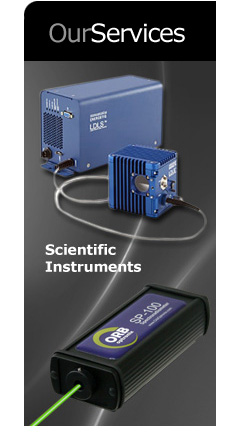Introduction to Federal Laser Device Requirements & Code of Federal Regulations Title 21
The Center for Devices and Radiological Health (CDRH), a division of the Food and Drug Administration, is responsible for administering most U.S. regulations which apply to laser light emitting products. Other agencies such as the Federal Aviation Administration (FAA) and the Occupational Health and Safety Administration (OSHA) have their own laser device requirements in certain areas. These also come with penalties for non-compliance. This discussion will concentrate on the CDRH.
CDRH Laser Device Requirements
CDRH laser device requirements can be found in CFR 21, Section I, subchapter J, parts 1002 to 1040.11. Laser products are classified into categories depending on the level of hazard they present. This hazard level is in turn based mainly on laser power output.
For example, a laser product such as a "line leveler" would fall under the category of “surveying, leveling or alignment”. Lasers in this category are limited to Class IIIa and lower power levels. The maximum power level for Class IIIa is 4.95milliwatts, for a small diameter, collimated beam. This is less than five one-thousandths of a watt of light. This is the same power level is as allowed in an over-the-counter laser pointer. Actual product classification may be significantly lower.
If at all possible, it is best to keep a product in the lowest-power classification, Class I. This will minimize performance, labeling and user informational requirements.
Certification Requirements for Lasers
Laser Products introduced into commerce in the U.S. must be “certified” by the manufacturer to be in compliance with regulations as specified in 21 CFR for lasers, Subchapter J, parts 1040.10 & 1040.11. This is a process of “self certification”.
Certification to meet laser device requirements must be completed prior to the first introduction into commerce. “Introduced into commerce” includes use, advertising or offering for sale, or delivering any units. Showing your product at an upcoming trade show would be a specific example of “offering for sale” as far as the CDRH is concerned. Thus, the product must be certified before being demonstrated or shown at a trade fair.
To certify a Laser Product the following must be true / be performed:
The product must meet the performance standards for the appropriate class (21 CFR, 1040.10 (f)). Performance features include devices such as protective housing, keyswitches, interlock systems, beam attenuator, labeling etc.
User documentation (user manuals) must be generated or modified so as to reflect the informational requirements of 1040.10 (h)
An Initial Product Report must be generated and filed with the CDRH. 1002.10 This is typically a 40 to 60 page technical document for each different model.
A certification test procedure shall be generated and performed on each unit being certified 1010.2 (c)
After initial certification there are additional compliance requirements such as record keeping and filing of annual reports, 1002.13. You also need to be aware of the details about how to handle alignment laser products and export units as well as other items. Additionally, in many cases dealers or distributors may have record keeping and reporting responsibilities. These vary with parameters including sale price.
The above is not an exhaustive list of certification procedures. You are provided instruction on how to complete each aspect of the requirements as part of our consultation services.
21 CFR for Lasers: Initial Product Report
To be in compliance with regulations as specified in title 21 on the CFR for lasers, an initial product report is needed. The Initial Product Report is typically a 50 to 150 page document indicating to the government the strategy and method by which your product will be compliant with laser device requirements. Initial Product Reports for Class I products tend to be a bit shorter, about 35 pages.
Certifying for Both U.S. and IEC Countries
A desirable strategy is to classify the laser product via the European IEC 60825-1 and CDRH Laser Notice 56 (Class 1). This allows the sale of a Class I product in the U.S. and overseas without further work and further reporting. Since changing products and compliance can be so involved and manufacturing and stocking multiple part numbers can be expensive, this can represent significant savings.
Also, in some cases the IEC certification scheme can give some leeway in allowing higher power levels if required due to wavelength compensation and apparent source size considerations.
The Code of Federal Regulations (CFR) Title 21 for lasers can be challenging to understand, and large fines can be placed on your company for failure to comply. Contact Laser Compliance today to avoid penalties and fines, and to make sure you are compliant with laser device requirements of 21 CFR 1040 and the international IEC standards.
|
 |

